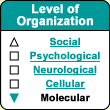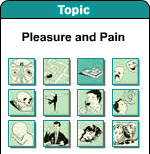| |

 |
 |
 |
Nearly 15% of all men and 30% of all women admit
to a craving for chocolate.
Over 300 substances have
been identified in chocolate. Some of these, including caffeine and theobromine
(another, less powerful stimulant) could actually cause dependency effects. But
the amounts of these substances in chocolate are too small to really have any
effect.
The same goes for phenylethylamine, a substance related to a
family of stimulants called amphetamines. For example, chocolate contains less
phenylethylamine than goat cheese.
Anandamide, a neurotransmitter produced
naturally by the brain, has also been isolated in chocolate. The neural receptors
for anandamide are the same ones to which THC, the main active ingredient in cannabis,
binds. The anandamide in chocolate might therefore contribute to the feeling of
well-being reported by “chocoholics” (though you would have to eat
well over 30 kilos of chocolate to experience effects comparable to one dose of
cannabis!).
Be that as it may, many scientists agree that dependency
on chocolate could simply be due to its taste, which causes a sensation of intense
pleasure that people want to repeat. | | |
| HOW DRUGS AFFECT NEUROTRANSMITTERS | | Dopamine
appeared very early in the course of evolution and is involved in many functions
that are essential for survival of the organism, such as motricity, attentiveness,
motivation, learning,
and memorization. But most of all, dopamine is a key element in identifying
natural rewards for the organism. These natural stimuli such as food and water
cause individuals to engage in approach
behaviours. Dopamine is also involved in unconscious memorization of signs
associated with these rewards.
It has now been established that all
substances that trigger dependencies in human beings increase the release of a
neuromediator, dopamine, in a specific area of the brain: the
nucleus accumbens.  But
not all drugs increase dopamine levels in the brain in the same way.
- Some substances imitate natural neuromediators
and take their place on their receptors. Morphine, for example, binds to the receptors
for endorphin (a natural "morphine" produced by the brain), while nicotine
binds to the receptors for acetylcholine.
- Other
substances increase the secretion of natural neuromediators.
Cocaine, for example, mainly increases the amount of dopamine in the synapses,
while ecstasy mainly increases the amount of serotonin.
-
Still other substances block a natural neuromediator. Alcohol,
for example, blocks the NMDA receptors.
Click
on the names of each of the following drugs to read about how they work and what
effects they have. Alcohol
----- Opiates
(heroin, morphine, etc.) ----- Cocaïne
----- Nicotine
Caffeine
----- Amphetamines
----- Cannabis
----- Ecstasy
----- Benzodiazepines
Cannabis The
sensations of slight euphoria, relaxation, and amplified auditory and visual perceptions
produced by marijuana are due almost entirely to its effect on the cannabinoid
receptors in the brain. These receptors are present almost everywhere in the brain,
and an endogenous molecule that binds to them naturally has been identified: anandamide.
We are thus dealing with the same kind of mechanism as in the case of opiates
that bind directly to the receptors for endorphins, the body’s natural morphines.
Anandamide is involved in regulating mood, memory, appetite, pain, cognition,
and emotions. When cannabis is introduced into the body, its active ingredient,
Delta-9-tetrahydrocannabinol (THC), can therefore interfere with all of these
functions.
THC begins this process by binding to the CB1 receptors for
anandamide. These receptors then modify the activity of several intracellular
enzymes, including cAMP, whose activity they reduce. Less cAMP means less protein
kinase A. The reduced activity of this enzyme affects the potassium and calcium
channels so as to reduce the amount of neurotransmitters released. The general
excitability of the brain’s neural networks is thus reduced as well.
However, in the reward circuit, just as in the case of other drugs, more
dopamine is released. As with opiates, this paradoxical increase is explained
by the fact that the dopaminergic neurons in this circuit do not have CB1 receptors,
but are normally inhibited by GABAergic neurons that do have them. The cannabis
removes this inhibition by the GABA neurons and hence activates the dopamine neurons.
In chronic consumers of cannabis, the loss of CB1 receptors in the brain’s
arteries reduces the flow of blood, and hence of glucose and oxygen, to the brain.
The main results are attention deficits, memory loss, and impaired learning ability.
General links about cannabis: | | |
| |




